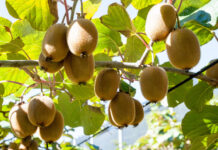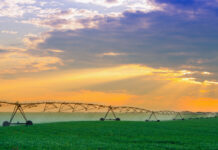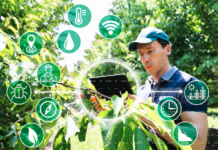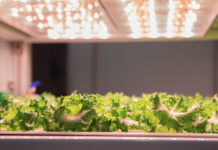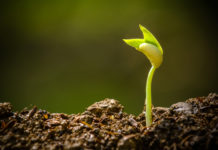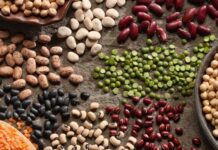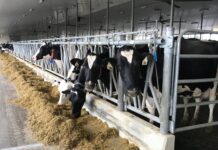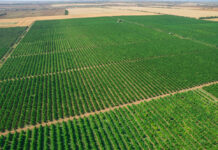[Music fades up, sounds of farm animals, tractors, computer clicks, and digital noise]
Hannah Senior: Our global agricultural and food systems are broken in lots of ways. As a species, we’re exceeding our planetary boundaries with extractive and unsustainable farming methods, and the industry is frequently plagued with poor working conditions, poor profitability for farmers and food waste.
In the first episode, we explored some of the issues facing modern agriculture and food systems, and why there’s a need for more agricultural technology to be introduced. In the second episode, we looked at the role of entrepreneurs in initiating some of the changes needed. This includes how to create a vibrant entrepreneurial ecosystem specifically for agri tech entrepreneurs.
In this episode, I want to talk about farmers and growers, how are they feeling about AgTech innovation and how it might affect them? Or has it already? Innovation and technology have been coming into agriculture for millennia, initially, a few thousand years ago, this was things like using wheeled vehicles. As with everything else, the pace of technology adoption has picked up over time. Around the Industrial Revolution came mechanization. And after World War II, it was synthetic fertilizer.
Towards the end of the last century, agriculture fell behind many other industries in terms of the pace of new technology adoption. But in the last decade, that pace has accelerated dramatically, with technological advances like digitization, gene editing, robotics, artificial intelligence and more beginning to make their mark. With this has come more investment. AgFunder estimates that $16 billion US dollars was invested in new companies focused on AgTech globally in 2020. And this seems to have accelerated as the COVID 19 pandemic has unfolded.
So have farmers been benefiting from this investment? What are their experiences of engaging with AgTech and entrepreneurs, and what technologies have been adopted with enthusiasm?
In this episode, the emphasis is on the farmer’s experience. We’ll explore the story of the startups themselves in Episode Four. Needless to say, farmers are not a monolithic blog, but in this episode, we’ll share some of their perspectives.
We’ll start with a case study which demonstrates what can go right and what can go wrong. Before exploring some other perspectives of some of the issues arising. I’ll be hearing from the largest agricultural representative body in Ireland, an arable farmer and precision AG expert from New Zealand and from a relatively uniquely farmer focused AgTech development program in the USA.
[Theme music fades in and out. Sounds of a tractor driving by]
Andrew Todd: So my name is Andrew Todd. I’m a grain grower from Western Australia and a 2020 Nuffield scholar. I have a farm in the central Wheatbelt of Western Australia. We grow wheat, barley and canola and I farm with my wife, and we have three daughters and two employees on the farm.
Hannah Senior: Andrew farms more than 4200 hectares of land. And one of the pressing issues he faces is how to deal with weeds in his cereal crops.
Andrew Todd: So the problem is herbicide resistance in weeds, which, unfortunately for us, Western Australia is about the best at in the world. We have pretty harsh environmental conditions. And so multiple sub lethal doses, which are not always due to not enough product being put in the tank by the farmer, but often due to conditions that have led to herbicide resistance issues.
Hannah Senior: Because of this problem. Andrew was on the lookout for a better method of weed control. Through a family member who had connections in the world of emerging AgTech, he heard about a potential solution to the weed control challenge; a young company
called Seed Terminator. The entrepreneur had done a PhD on the technology involved and was gaining traction with a product that could, in theory, help drastically reduce weed seeds in the field. They were looking for farmers to trial their innovative solution.
Andrew Todd: That was gaining momentum; they were looking to get some of these mills out onto harvesters for a small release. I think they released nine machines in the first year, so my brother-in-law made the introduction and we went from there.
Hannah Senior: The machine controlled weed seeds by capturing them as the crop is harvested, preventing them from returning to the seed bank in the soil ready for germination the next year.
Andrew Todd: It was something that I’d been keeping an eye on and the whole industry had really, and we and it was something that people were looking out for, that we needed. This issue of herbicide resistant weeds was not going away. Burning, while effective, is another job. There’s an element of risk with it. There’s some environmental issues to consider and social impacts. So it was exciting. I thought: “This is the way of the future, I’m happy to be part of that.”
Hannah Senior: Andrew hadn’t worked with startups or this kind of product innovation before, but after a period of discussion with the company and an application process to participate in the trial, he decided to go ahead.
Andrew Todd: We had a bit of extra harvest capacity. So I did have some level of realization that this might have an impact on our harvest, that there will be teething problems. But I thought with two machines, we’ll get away with it because only one was going to be held up with this trial machine fitted to it basically. There was a contract to purchase the machine. There was also a share offer, we couldn’t have the machine without taking out the share offer. So I guess that was your show of faith and commitment. And then yes, the third aspect was a confidentiality agreement, because it was new tech, they didn’t want prying eyes in the paddock. It was always, you know, termed as a commercial prototype. And I guess by nature,
now knowing what that means, I would view that differently. But at the time, I thought, well, “if you’re ready to put this on a machine in my paddock, and you’re asking me to pay you for it, then it must work.” So my expectations were that it would go on, there would be teething issues, we would sort those out over a week. And then it would be minor adjustments, and perhaps daily maintenance required, and we get to the other end of harvest. The reality was quite different.
Hannah Senior: Andrew agreed to buy the machine, which would attach to the back of his combine at a discounted price. But it was still a significant investment.
Andrew Todd: The steel, if you like the hardware, we paid $70,000 Ozzie dollars for and we were also offered a 1% share in the company. And that was $20,000. So the whole outlay was
$90,000 at the time, but $20,000 of that bought us a 1% stake in the company. So I think that was a way of us getting some skin in the game, I guess, to be on board to help make it work in those initial difficult stages of, you know, the final stages of R&D in the paddock. But also to incentivize us, I guess that there’d be more in it for us in the future to reward us for the risks that we were taking at the time.
Hannah Senior: The hardware was delivered and Andrew set to work trialing it, but it didn’t pan out the way he expected.
Andrew Todd: Ultimately, what happened was that we had all sorts of bother: the mills, the drive system was the challenge. So the mills were very well researched, the PhD had every bit of information you can imagine about physics around the mills, but the engineering solution of making them spin on the harvester was reasonably ad hoc. A lot of off the shelf componentry used, which wasn’t up to the job, especially not in the paddock conditions. So a lot of the testing or nearly all the testing prior to us having one on our machine was done in a shed – bench testing, basically, A bit like trying to do a desktop analysis and then putting something out in the field and finding out that will actually it’s quite different when you put it into these circumstances where there are temperatures of 40 degrees, there’s massive loads on it, because there’s large volumes of crop being pushed through it, you know, 18 hours a day.
Ordinarily that machine that the seed Terminator was fitted to, we would expect to try and achieve somewhere between 80 and 100 hectares per day out of the machine. And we need to. The issues that we were having were numerous, with mechanical issues primarily with the Terminator. That machine did 650 hectares in 21 days before we ultimately removed the Terminator because we couldn’t accept that productivity loss for any longer. And we just weren’t getting the support that we needed from the engineers who developed it. They were in South Australia, they were trying to get machines fitted up in other states, the main engineer was having a baby so everything was conspiring against its success.
And I was just so dogged and determined to make it work because I’d invested emotionally and financially in it that I let that occur for 21 days and ultimately it costs us I estimate
$200,000 to $300,000 of canola losses because we had a 40 degree day which is not unusual, but we also had 40 to 60 kilometer an hour winds and that dropped a lot of canola on the ground as you can imagine and and when it’s on the ground it’s got no value. So that was a hard lesson.
We needed the support, we needed boots on the ground, hands on the spanners, eyes on the problem, not a phone in my hand in a paddock with a dodgy reception, and I’m not an engineer, and I’ve got other things I need to achieve. And we couldn’t get that. So it just wasn’t it wasn’t going to occur. They didn’t have the resources, and they had other things going on.
Hannah Senior: So the trial cost Andrew dear. But this story does have a pretty happy ending, despite both his financial losses and the time he put into the trial.
Andrew Todd: It’s a good story. The next year, I was given a new machine, a brand new machine, no cost and refitted it to a new harvester because we had a new harvester. And it was much better; the drive line, the mechanical issues that we had were largely solved – real credit to them. A lot of engineering went on in those 12 months. They knew what the problems were. And they fixed them.
Wear became the next issue. So the mills were wearing out, they’re expensive to replace. So again, that was just learning. They didn’t know what was driving the wear, they didn’t know what materials to use to reduce it, and balance the cost. So by 2018, the mills were slightly redesigned, very minimal changes, just minor that made be differences in the productivity and the performance of the machine. And to the present day, they’ve now sold around 430. And there are some in Canada, some in the US. And they’re working with Zürn, which I think are a German organization. It’s running right now, Hannah, I’ve left the paddock to come and talk to you and fingers crossed, it is still going, harvesting barley. It’s part of our system. And as a testament to if I look out the window to the farmer to my East, there is one on his machine this year. And if I look out my window to the farmer to the West, there is also working on his machine this year, so the adoption is starting to increase.
Hannah Senior: It’s worth noting that in Andrew’s case, the machinery was developed with a very real problem in mind. And it was extremely innovative in its function. The problem was not how the machinery worked, but how it interfaced with the existing kit.
Andrew Todd: There’s a farmer’s son from Kangaroo Island, that just is quite clever and did very well in physics and engineering. And he doesn’t come from that corporate cutthroat background. But you can genuinely see the passion that he has. And the motivation is to provide a solution for farmers. I genuinely don’t think that his motivation is to, you know, end up with a hundred foot riviera (yacht) and living in the Greek islands, like, that’d be nice, but that wasn’t why he took the first step
Hannah Senior: To develop new technologies for agriculture, we’re going to need farmers and entrepreneurs to work together. This story has lots of examples about how not to do it. But new solutions need trialing. How else can you learn where the bugs lie in a system?
[Theme music fades in and out]
Hannah Senior: We’ve just heard a vivid example of what can go wrong when farmers and entrepreneurs come together. The shared goal was to trial the product so that it could be
refined and brought to market more widely. But it’s a classic example of good intentions going wrong, and underestimating the many ways in which things can go awry in agriculture.
How and when to engage with the sharp end of improving agricultural production has been one of the areas that entrepreneurs, farmers and investors have had to wrestle with and improve upon. Craige MacKenzie is a farmer from New Zealand. He’s been farming since the 1980s and founded Vantage New Zealand in 2010 with his wife and daughter to help supply precision agricultural systems and training to farmers. He’s met a lot of AgTech entrepreneurs and knows too well how difficult the process can be.
Craige MacKenzie: It’s not hard to find ways to make things work, if you have a passion to want to change. But technology that is over promised and under delivers totally undermines the whole technology whether you want to call it AgTech, whether you want to call it Precision Agriculture, but probably undermines the efficient farming philosophy.
Hannah Senior: In Andrew’s example, the product was developed with a clear understanding of the problem in hand and the solution needed. But Craige notes that many entrepreneurs develop a technology without a real understanding of what farmers need. A second related problem is that all too often AgTech innovators do not involve the farmers with the early stage development of a product or when they’re defining the problem they’re seeking to solve, missing valuable insights.
Craige MacKenzie: So often, they are poles apart, of what they’ve designed, to what the farmers actually need. That’s a big challenge. Until you go to some of those conferences – and it’ll be, you know, the technology people talking to themselves, comparing which kind of technology they’ve got. Not actually around getting stuck in and talking to the farmers and sitting at the table. Because often those times they’re sitting around a bar afterwards or sitting at a dinner table and having a chat around what they can do and how they can deliver. So there’s a massive disconnect in that space. And saying that we have a lot of those people come in the door, to talk to us to get, as you said earlier, to be able to get us to try your technology and adopt things that they have available. But will be extremely strong, I guess,
around the constructive criticism of what they’ve and how it might work, and where the failings are. Some of them don’t actually want to hear the bad bits. But actually, they actually just believe it works.
Hannah Senior: Pete Nelson, the founder of business accelerator, AgLaunch, echoes Craige’s sentiments, noting that there needs to be a shift in the way AgTech businesses think about farmers.
Pete Nelson: Another myth is that you can build an ecosystem without the farmer or the farmer should be just viewed as a customer. Five, six, seven years ago, when you would go to a big AgTech conference, with all the big multinational players and venture capital, farmers were rarely talked about. Since then, at least farmers are talked about, but the framing is that “we need to bring the customer closer, we need to interact with the customer more.” In farmers, there’s this myth that these are all individuals, like we would see a customer for an Uber app or on Facebook, as opposed to b2b partners, opportunities to joint venture or form partnerships to commercialize. The reality is farmers are all business, this myth of these are just random customers, and there’s a ton of them. In our country, probably 70,000, total supply over 90% of the food. So it’s a small fraternity of people that are themselves accredited businesses that are running a business.
Hannah Senior: In addition to entrepreneurs failing to understand the farmers real needs, and not adequately involving farmers in development of solutions, a third, and perhaps most common complaint about entrepreneurs in AgTech is that instead of having a problem and a technology to solve it, they have a technology and trying to find a problem in need of that solution. This also includes creating data without an obvious benefit or insight for the farmer says Ethan Cleary at the Irish Farmers Association.
Ethan Cleary: Data in isolation is nothing you know, so a farmer, from my experience, anyway, they don’t care or know about data, what they see is information. They see something that will help them solve a problem they have or help to be more productive. So the goal with all of this is to help me become a better farmer. And how do I do that is by getting, you know, accurate,
up to date information, whether it’s diagnostic or predictive- it’s stuff that will make an impact and help me farm better. So it’s almost, you know, subconscious, it’s just there. It’s information that I’ve got, that I understand. And that’s the key around this stuff is where – that the people that have been successful, the organization startups is been able to convert that data. Again, the data is almost ephemeral in this: it’s how that is packaged and delivered to the end user, who in this case, is the farmer who has to make a decision around “how much fertilizer will I buy for the upcoming season?” Or “what new trials do I need to look at in order for me to, you know, optimize what I’m planning to rotate my crops this year” let’s say. So it’s all matching that with information.
Hannah Senior: This can be an entirely legitimate complaint, if there isn’t a fit between product and market, and when coupled with a perceived attitude of “let me tell you where you’re going wrong”. It is especially unpalatable. Sometimes however, it’s unavoidable. That process of iteration developing a hypothesis about where technology fits in and testing it, is a critical part of technology development. And it’s in everyone’s best interests for the farming community to find ways to engage with this process. Part of the magic of innovation, and one of the keys to entrepreneurial success is adjusting to better match the technology or solution to the customer’s needs. This is the best way to understand wants or needs that might not be immediately evident.
Ethan Cleary: The expectation is for a consumer kind of user experience because people are used to using, you know, these lovely well designed smartphone applications that allow you to do stuff like book a taxi or reserve a table or even shop online. But they have to be married with a certain level of complexity. It’s almost like b2b type level of complexity that’s required there in terms of quality assurance in terms of audits, farm inspections, in terms of actual management records and data to help you become more productive. And look at this, the kind of model that we’ve explored more than anything else is actually having a cohort of farmers that are willing and will be compensated, whether through equity or straight kind of funding to be involved with startups – to actually be, even before they get to a minimum viable product level, to actually sit in the cab, walk around the farm, understand what is happening, and not
just from a functional point of view, but also the social elements of their you know, that the actual emotional level, what drives what, what can you be done to actually make the overall work life experience better on farms, and get better insights, you know, and work that way.
Hannah Senior: So the problem becomes one of organization, how to ensure farmers and entrepreneurs can collaborate constructively, and focus on the right problems. Sarah Nolet, the co-founder of Australia’s AgThentic, observed that it’s vital for both farmers and entrepreneurs to connect at all stages of startups development, and that we need to lose the idea that it’s always the farmers that are resistant to engaging.
Sarah Nolet: Now, maybe culturally, Ag is much more risk averse than venture. And so you do get these tensions where startups will say “this is our vision, th is is what we’re going to build”. And then the farmers might say, “Okay, come back when that’s done”. But that doesn’t really work, right? You need the feedback early on many iterations and trials over time. And so that’s where these kinds of support structures in the ecosystem need to exist to actually help that process play out, because you can’t wait in the tech world for things to just be done. You need user feedback early and often. I’m always sensitive to the blame that gets put on farmers. And I know, that’s not what you were saying, but there’s often this kind of, “oh, well, now the farmers are ready for it”, or “now they’re listening”. And it’s like, also, now that technology is being presented in a way that actually adds value, or you’re not coming with a promise that you can’t deliver on or you’re being realistic about expectations. So I’m always loath to put it on the farmers.
Hannah Senior: She recognizes, though, that the tides are turning.
Sarah Nolet: There is a lot more of an ecosystem where there’s support for both sides to connect and find each other and kind of translate across the gaps. And so it’s not left up to chance as much anymore. If you want to get involved, there’s pathways and programs where you can get that feedback, where you can learn about how the other side’s thinking and be in that environment that fosters collaboration and creativity and trials and all the things we need to develop new technologies.
Hannah Senior: It’s really critical that farmers are proactively engaged in the development of technologies, sometimes to identify issues that need solutions, sometimes to test ideas that farmers and growers themselves may never have thought of. Done well, this is likely to be a time and energy intensive process, which likely also has cost implications. It involves building trust, delivering on promises, and ideally ensuring a shared interest in success. One of the most structured ways I’ve come across to do this is the example of AgLaunch.
[Theme music fades in and out. Sounds of farm animals]
Hannah Senior: In Episode 2, I talked about business accelerators, which are typically financed by a combination of VC funds, large agribusiness companies and/ or governments. The part of the ecosystem that is often much less conspicuous in these arrangements is the farmer or grower community themselves. One organization I spoke to, AgLaunch, turns this around and puts the farming community in their particular geography, the Mississippi Delta region of the US, at the heart of what they’re doing. AgLaunch was developed to do things differently, to put the needs and interests of the farmers right at the center of the innovation process. And do this in a way which also benefits entrepreneurs by creating a greater connection for trials and development.
I wanted to explore and understand this model more carefully, as I think it offers some ideas about how the entrepreneurial process could be reconfigured to have greater benefit for farmers. Pete Nelson, Executive Director of AgLaunch explained to me how it all came about.
Pete Nelson: I started my career in agriculture over 20 years ago as a small farmer and got very engaged in how do we scale, growing new types of crops and creating new opportunities in our region, that eventually brought us into sort of a widespread view of how do we change the overall economics and value chain opportunities for farmers, and also for those that consume food and want to have healthier and better food.
And so we started AgLaunch seven years ago as a way of creating an ecosystem to support a lot of things that I care about and my colleagues care about. We’re moving as fast as we can in
Western agriculture, in general, driven by consumers into a traceable, attribute based, sustainable production base and away from just the value of “No 2 corn minus input costs traded on the Chicago Board”. And so building that structure is fundamental to what we’re doing, how do we measure sustainability, ranging from worker wellbeing to water to, you know, how we increase wildlife, and diversity, all of those things. There’s kind of two platforms from a business perspective on what we do. One is assisting technologists that are creating AgTech companies, by connecting them with farmers very early in their iteration cycle, and essentially creating a partnership where farmers help proof of concept, beta test and scale technologies. And, at the AgTech startups, get a path to market that is more efficient, effective than what the current offerings are.
Hannah Senior: Pete went on to explain that to do that well, he also had to build all the things that you would normally have in an innovation ecosystem, regardless of the sector, including a business accelerator program and investor partners.
Pete Nelson: So we have, you know, if you look at a chart on what you need an ecosystem, we built all the normal things. But we’re also building some really unique tools to make this whole thing move along even more efficiently. This uniqueness is based on the fact that it’s anchored with farmers, and not multinational AG companies. And then we have supporting networks of farms and research centers that are sort of our platform.
Hannah Senior: AgLaunch runs a business accelerator for entrepreneurs who want to trial their innovations within the network of farmers. And they proactively seek innovations to solve problems that those farmers want solving. I was keen to learn more about this structure and I asked Pete to explain the process.
Pete Nelson: We have a network of farmers there – so these are the 3-5% farmers that are always willing to try new things. We’ve organized those farmers into a network. And that network then identifies what are real farm problems that we’re trying to solve? Examples of those – and some of them are non sexy examples, but things like herbicide spray drift, or herbicide resistant weeds, or more precision planting, or things that affect market dynamics.
And so we identify these problems. And then we go out and do challenge events where we advertise internationally for companies or technologists that want to try to address those problems, and then match those up. The farmers are engaged at every step of identifying what we’re targeting, screening the technologies and the deals, giving feedback. The things that we choose to invest in and grow are because our farmer partners have recommended those.
Hannah Senior: There is an admirable clarity in AgLaunch objectives. While many actors in the agri food system might have an interest in bringing new technologies to market, AgLaunch is unashamedly focused on how to bring benefit to the agricultural community in its region. It’s dedicated to helping its own farming communities shift their position within the food system, and be proactive in finding solutions to problems that farmers themselves see. In doing so it also helps bring entrepreneurs they work with closer to their market.
Pete Nelson: Often agriculture, I believe it’s the same globally, certainly in the United States, is viewed as this big, combined, mashup of all the different players that are involved in the system. My argument is: entities that support innovation, ultimately are going to have to decide are they working sort of generically for that whole body? Or are they working for certain components – and there’s nothing wrong with working for various components. Our component is: we work for farmers, fundamentally, and we work for consumers, which means we may be – and are, in fact, looking to disrupt fundamental other parts of the value chain, the supply chain, based on how we think about what will bring value to the farmer.
Hannah Senior: The issues we’ve been discussing so far have mostly been around the development and trialing of new technology in the field. But once a technology has been tested and proven to work, and the startup is ready to launch it to the market, the next step is to get adoption – which comes with another set of challenges.
[Music fades in and out]
Hannah Senior: The adoption of new technology within agriculture, how to increase adoption, what the barriers are, is a much research topic. There is no doubt that technology adoption in
agriculture is slower than some other sectors for lots of perfectly good reasons. I read a wonderful academic paper from 1950 by Ryan and Gross about the adoption of hybrid corn in Iowa. And the observations from half a century ago, are very similar to those that we see with other technologies today, suggesting that: A) the factors influencing adoption are pretty deep rooted, and B) We keep asking the same questions! An interesting point to note is that technology quickly stops being thought of as technology when it’s been widely adopted. Few would consider the use of a tractor driven by an internal combustion engine, or glass house growing as “AgTech”. And yet each technology is an enabler that allows the next one to be built on top of it. By way of an example, an innovation that was widely adopted, which proved to be an enabler for lots of subsequent innovations is the smartphone. As Ethan Clearly explains:
Ethan Cleary: The smartphone came along and it was just fascinating to see how quickly that wave kind of washed through agriculture. So I would say within two years, and we have a commercial arm and IFA where we partner with big brands around power, energy, telecoms, mobile. So our IFA mobile offering, we could see quickly within two years, we went from having 20% smartphone sales to actually over 80%. So you could see that the tipping point happened quite quickly. Then farmers were using their smartphones in very, you know, unique and innovative ways.
Hannah Senior: Farmers can and will adopt technology when it works for them. Craige MacKenzie suggests that for farmers, the steps towards more AgTech are often just as much about mindset as they are about the technology in hand.
Craige MacKenzie: Farmers have always been innovative, have always been looking for ways to do new things. It was interesting because I actually was with the guy who started the International Society of Precision AG and he asked me to present in 2008, when I did my Nuffield he asked me to present at the conference. He said “we don’t do precision agriculture”. He said, “Well, actually, you know exactly how many kilograms of nitrogen it takes to grow a tonne of wheat, you know, exactly your inputs and your outputs. So you might not know it, but
you’re actually doing precision agriculture”. That was an interesting mindset change for me, because what it meant was, you now get on the bus to where you believe in what you’re doing. And I think that’s one of the biggest things is around believing what you’re doing is innovative and big step changes. But then the step changes aren’t actually the technology per se, they’re actually the mindset change.
Hannah Senior: But whereas hybrid corn reduction in the 1950s happened really rapidly, as did the use of the smartphone, getting farmers to change other aspects of their practices can be very challenging.
Pete Nelson: The reality is that is a small subset of farmers using these technologies now, and that we really have not as an agriculture community adopted technology in terms of its full potential at all. And so what we tend to think about it like there’s this playing field we can just lob a new technology into in reality, there’s some tough just fundamental challenges on even how to think about where things fit on, under the farm budget.
Hannah Senior: Reinforcing Pete’s point, at a recent event, I went to a speaker referred to an off the cuff comment by someone from a major agricultural machinery company, saying that less than 30% of precision agriculture equipment sold is turned on, let alone used effectively. That’s a lot of kit that’s been sold and isn’t being used.
So what are some of the main barriers to adoption for farmers? One reason often overlooked by startups keen to get farmers and growers to adopt their innovation is simply: risk. Sarah Nolet of AgThentic gave a great example of this. Many of the early AgTech solutions were software based farm management programs, combined with farm IoT devices like sensors and monitors. But they often fail to take into account the many moving parts or knock on effects that one piece of software or equipment can affect if it goes wrong.
Sarah Nolet: When you’re the farmer, you’ve not only got that, that kind of business decision, but you’ve got the whole logistics of the operation sitting behind it. So that one decision about whether to go check that tank is in context of everything else you’re managing on the farm.
And the risk of getting it wrong is often something that the tech companies didn’t consider. So yes, you might save a bit of money on (just to take irrigation, for example) on your diesel bill if you use the sensor and reduce how much you use, but the risk of not having enough water and the crop was in distress and yields are lower – that’s your whole income for the year. The stakes are just way higher.
Hannah Senior: The risk that the technology won’t work at all, that the farmers’ yield will be impacted, or simply the cost and effort to implement it will outweigh the benefits are all big considerations that AgTech entrepreneurs need to mitigate. We saw this with Andrew Todd’s case study. The risk of his Seed Terminator and not working wasn’t that he’d get weeds, it was that the new technology would negatively affect his yield and therefore income. And this is precisely why really thorough and extensive field trials are so important so that farmers can have confidence about how and if a technology will help in this specific context. Ethan Cleary at the Irish Farmers Association broke it down for me:
Ethan Cleary: It has to show a clear return on investment for a farmer. That’s the hardest thing, I think, with technology adoption – outside of infrastructural stuff like connection or the cost of hardware. If I do this particular thing, if I adopt this technology, I have maybe one chance this year to grow a crop – this technology better provide for me a better show that it’s going to make a difference, it will make me more productive or make me more profitable. So how do you do that? You know, and this is where word of mouth is extremely strong within agriculture. Word of mouth and agri-media will be probably the two biggest ways to kind of diffuse innovation amongst the sector. You need to find a way to show that your technology – and this is why if I’m ever working with startups in this space – I always say, “you need to show that this product or service or new offering is going to have a big change or some significant impact on the value proposition”. So you quantify it, you say that “this technology is going to help reduce my fertilizer spend by 15%”. Or “it’s going to increase the weight gain on my animals by, you know, 10 kilos per head” or whatever, you know, something that is very concrete backed up by testimonials, and has to be verifiable. But I think that’s the way and just similarly with anybody who’s coming in trying to, you know, put in a new environmental driven
solution, it has to have a return on investment, it has to show that there is value here. Whether it is reducing the cost of something, whether it’s going to increase productivity, while also enhancing environment that has to be very clear from the center, if at all possible, as well. But it first and foremost: start with the farmer, how is this going to help you be better?
Hannah Senior: Another reason for adoption challenges is simply the level of complexity and diversity in agriculture. Here, we could do with learning from earlier mistakes. Agriculture deals with really complex biological systems, and immense variation across soil types, climate types, animal and plant genetics, to name just a few of the factors. I would argue that one of the ways that the Green Revolution went wrong was that in focusing solely on the short term priorities of high yield and low cost, we lost sight of complexity. When we reduced agriculture to something like an equation, like “seeds + water + nitrogen, phosphorus + potassium = crops”, we’re missing all the important but complex knock-on issues. In this sense, the farmer’s accumulated intuition has to be respected. Craige MacKenzie was keen to get this point across, too:
Craige MacKenzie: One of the big problems is: the minute that they think they’ve got all the answers, and they think the artificial intelligence is actually going to take over, two things happen. One, the farmers feel a bit threatened, because he/she will have been farming here for generations. And the other part that you’ll start to lose is the skill level around food production. This isn’t artificial intelligence where, once you maybe get the product in a pack house, and it can sort out a kiwi fruit, it’s a different size, or a different color or a different shape to the other ones. This is when we’re in the field, and we’re actually living in a biological system. And you can go and stand in a crop and go “something doesn’t feel right”.
Now, there’s not too much science behind it when you say that something doesn’t feel right. And I’ll do that from time to time as well. But it’s actually taking that instinct that the farmers and understanding what the crop is, and then saying, okay, “something’s not right. What are we going to do?” And you’ll make appropriate decisions, whether it’s fertilizer, whether it’s water, whatever it is, that need to go on, based on history, based on experience, and based on what you see as coming in the weather forecast, what’s happening around you. And we – in my
opinion, I don’t think we ever want to lose those skills from the farmers. We need to enhance the skills. That’s what the stuff should do, and not try and replace it.
Hannah Senior: Craige went on to say that given the diversity and complexity of farming, we should have a high level of confidence that for any given problem, there is no one simple answer.
Craige MacKenzie: You know, like this isn’t a silver bullet situation with technology. This is a silver shotgun. There are multiple things that come into play here. And the more layers you get, the more complex it gets. But actually, the better the outcome becomes, it gets better and better every time you put another layer of detail across it.
Hannah Senior: Pete Nelson also considers AgTech to be just part of the solution, not the solution.
Pete Nelson: And one of the up and down issues we have to deal with is how much hype is hyped around certain things. There’s still a prevailing attitude, even 10 years into this modern boom of venture capital and interest in activation, there’s still this prevailing thought that there’s some big silver bullet, that if you just figure that out, then we’re gonna be able to feed the world. And so that we’re going with a massive global enterprise to deal with a barrage of challenges, and that there’s not going to be any silver bullets. But there’s going to be a portfolio of solutions that are constantly adapting.
Hannah Senior: When the hype around a new technology starts to suggest that it’s the one thing that will save the world, we should start to be suspicious. Adoption of technology can happen very quickly. But as a rule, it’s often slower in agriculture than in other sectors, for lots of entirely understandable reasons, including risk, complexity, and diversity of agricultural contexts and growing cycles. These are structural factors. Another factor, though, is the simple question of who is going to pay for it.
[Music fades in and out]
Hannah Senior: In Episode One, we touched on farmer profitability. That’s part of the problem facing AgTech. Taken as a whole, most farming businesses don’t make much money. There’s a much smaller profit pool in primary production than elsewhere in the value chain. Although farmers might hold wealth in the form of land, this is highly illiquid. Few farmers have the cash or experience to invest in startups or trialing in a significant way. In Andrew’s story, he was in a position to invest in some new technology. It cost him a lot more than he expected, as the main costs weren’t the equipment, but the knock-on implications. But he was able to financially weather the storm. This is not always the case. A farmer’s ability to invest financially cannot be taken for granted.
The lack of resources goes beyond the financial. To trial an innovation, give feedback or take a risk on a new way of doing things involves investing other resources. Time and energy has an opportunity cost that time and energy can’t be spent elsewhere. Most farms and growers don’t have the same specialist skills and knowledge to focus on innovation in the way that other actors in the value chain, such as the brand owners or grain traders, might have.
So if farmers don’t have the resources, where else in the value chain can AgTech look to aid uptake? Sarah Nolet noted that there’s an increasing trend towards focusing business models on meeting the needs of other organizations in the food system, who are able and willing to pay for this innovation.
Sarah Nolet: What we’re seeing now – it’s actually really exciting and we think a lot about it at our fund – is unlocking the big incentives in the supply chain. So a lot of the digital disruption opportunity that we’re seeing is in the middle of the supply chain with processors with brands with consumer packaged goods companies, because they’re seeing the strength of demand from consumers, the pressures from investors around climate disclosures and ESG risks and the sourcing risks in terms of our supply chains. And so they need to be thinking about suring up that supply and proving the credentials of it. And so for them incentivizing adoption of something at the farm level makes a lot more sense. And for a farmer saying, “Okay, well I’ll use this technology, so that my customer – who I’m already selling to- will give me a premium
so that I can actually sell to them or open up a new market”, you really change the economics and the incentives.
Hannah Senior: Environmental impact reduction measures are a prime example of this approach. A farmer might say “it’s hard to go green when you’re in the red”, but a consumer facing brand, a fast food chain, a supermarket, a snack manufacturer, may want to ensure its suppliers provide outstanding animal welfare or maximize soil carbon sequestration, in order to fulfill their brand promises. It’s in the brand owner’s interests to invest in technologies that help meet customer’s demands for sustainability. And because brand owners are often so large in relation to farmers, they have the market power to insist on producers using these methods as a price of entry for being a supplier.
In the long run. It’s not clear how AG innovation will be paid for. There are examples of customer facing brands investing in technology on behalf of their suppliers. But the dynamics of the food system as it currently operates suggests that farmers and growers as a group are likely to be the ones who have their margins squeezed as they’re asked to comply with their customers’ needs.
This is a worry but the rights and wrongs are complicated. Some of the big brand owning companies, Unilever, PepsiCo, McDonald’s to name just a few are organizations with tremendous power to affect change. The scale and reach of their supply chain mean this is a natural place to focus if we want to see the negative impact of our food system reduced. The scale of the challenges we face, I’m afraid, don’t allow us to wait solely for utopian solutions that benefit everyone equally.
[Music fades up and down, sounds of farm animals]
Hannah Senior: The entrepreneurial process in AgTech relies on engagement from the agricultural community for trials, context, feedback and advice. Some of this costs money, some of it costs time, and sometimes it costs land or other resources that would otherwise be used for production in order to do the trialing. In any event, a lot of it involves goodwill.
Genuinely speaking, this is willingly given because it can result in better, greener and more productive agriculture and possible solutions to challenges that frustrate farmers and growers.
As the AgTech community has developed, and as the volume of entrepreneurs and entrepreneurial innovations increase, the number of opportunities to bring these communities together with growers and farmers has also increased. This enables those who are most interested in new innovations, and who are motivated to try to solve particular problems to engage with entrepreneurs focused on the same goals. But is it fair to rely on farmers’ goodwill in these relationships? Trialing and engagement with entrepreneurs brings a host of benefits to those farmers who are interested in innovation; new ideas, solutions to problems and potentially greater profitability. But I would argue that the interests of those farmers who engage in developing new technologies could be better aligned. If things don’t work out, and the idea fails, everyone loses. But if a new company is successful, the entrepreneurs and investors have the opportunity to become rich, while those early trial partners, and the agricultural community as a whole stands to become, well, paying customers.
In the next episode, I’m going to be speaking to entrepreneurs in the AgTech space to hear their side of the story. I’ll be asking them how they find engaging with farms and trials and feedback and their experiences securing strategic partnerships, funding and routes to market. I’ll also be exploring the downside of entrepreneurship, and how it can be a very bumpy road to success. Until next time, thank you for listening.
[Music fades in, sounds of farm animals and digital beeping sounds]
Hannah Senior: Thank you for listening. I asked my interviewees for recommended background reading about the topics we discussed in each episode. You can find many of these and other references I found helpful in the show notes.
For more information on ag tech entrepreneurship, including interviews with the contributors and other AgTech resources, visit AgTechThinking.com.
I’d like to thank the Elizabeth Creek Charitable Trust for their generous support which made this podcast possible. The project arose as a response to being accepted as a 2020 Nuffield Farming Scholar, but finding my travel plans were frustrated by the covid 19 pandemic.
[Music fades down]

